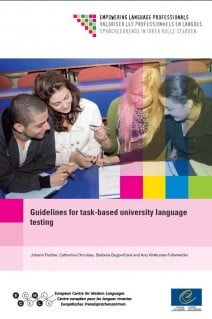



This publication is targeted at:
• decision-makers in university language teaching and testing (e.g. heads of university language centres or language departments);
• teachers and testers of languages for specific purposes in higher education;
• language teacher educators;
• other stakeholders in university-level language instruction and assessment.
Guidelines for task-based university language testing is a practical manual for those language teachers and testers who are looking for a valid tool to measure their students’ language skills in a meaningful way. It shows how to link the language skills taught with those needed in studies and later in working life. It helps language instructors, who already conduct task-based language courses, to design corresponding tests and to evaluate their students’ language performance. The publication also highlights the benefits of task-based language testing for all the stakeholders.
For further information and materials relating to this publication, visit the website:
http://gult.ecml.at.
Table of Contents
Part A: Guidelines
1. Aims and objectives
2. The GULT context
3. Target audience
4. Why task-based LSP testing: the logical next step from task-based LSP teaching
4.1. Task-based testing in various disciplines
4.2. Task-based / action-based approach to language testing
4.3. Task-based testing and the communicative approach
4.4. Task-based approaches
5. Essential features of task-based assessment
5.1. The construct
5.2. Integrating the four skills
5.3. The structure of a task-based test or exam
6. The potential benefits and beneficiaries of task-based language assessment
7. Challenges and limitations
7.1. Psychometric concerns
7.2. Practical concerns
7.3. Other concerns
8. Evaluating test taker performance
9. Potential uses of task-based tests / exams: how to exploit task-based tests
9.1. Achievement tests: end-of-course exams
9.2. Proficiency and prochievement tests
10. How to develop a task-based test
10.1. Test design
10.2. Next steps in test development: trying out
11. Bibliography
Part B: Resource documents
Resource document 1: About tests and assessment
Resource document 2: Examples of the implementation of task-based testing in university proficiency testing systems: “Make it real”
Resource document 3: Examples of task-based tests and exams
Resource document 4: Examples of the implementation of task-based assessment in university language teaching
Resource document 5: Assessment grids
Resource document 6: Definition of “task”
Resource document 7: Definition of “authenticity”
Resource document 8: Steps in developing a task-based language test
Resource document 9: Glossary

This publication is targeted at:
• decision-makers in university language teaching and testing (e.g. heads of university language centres or language departments);
• teachers and testers of languages for specific purposes in higher education;
• language teacher educators;
• other stakeholders in university-level language instruction and assessment.
Guidelines for task-based university language testing is a practical manual for those language teachers and testers who are looking for a valid tool to measure their students’ language skills in a meaningful way. It shows how to link the language skills taught with those needed in studies and later in working life. It helps language instructors, who already conduct task-based language courses, to design corresponding tests and to evaluate their students’ language performance. The publication also highlights the benefits of task-based language testing for all the stakeholders.
For further information and materials relating to this publication, visit the website:
http://gult.ecml.at.
Attention, en vertu de nos conditions générales de vente, l'achat des PDF/epub est réservé aux particuliers.
